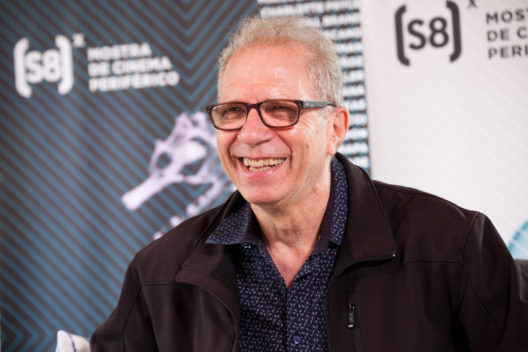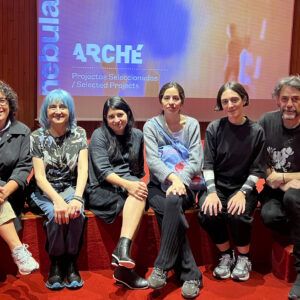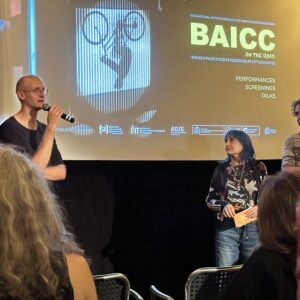 You’re a filmmaker and a preservationist, or, as you have said yourself, “an accidental preservationist”. How did you start preserving and restoring film?
You’re a filmmaker and a preservationist, or, as you have said yourself, “an accidental preservationist”. How did you start preserving and restoring film?
When I started making films, my first jobs were in animation, with an animator camera. That led me to thinking film frame for frame, and I started making works in 16 mm that worked that way, with re-photography. That led me to optical printing, optical printing led me to doing blow-ups of 8 mm and super-8 mm film, and I did that for many years before I knew there was this thing called preservation. I was already doing preservation, I just didn’t know that was its name. I came to preservation as an artist.
Would you say that your preservation and your creation work are related? Do they intersect, do they influence each other?
When people hear that I am an artist and I work in the archives, they usually think that I make films that use archival footage, but that’s not what I do. The thing that attracts me to both things is that I approach both with an interest in solving puzzles and understanding how things work, and questioning the meaning of things –how we know things and how we perceive things. For me, the exciting thing about making art is discovering what it is I have to say, because I don’t know. Art is a way for me to discover that. And the exciting thing for me as a preservationist is entering the mind and spirit of another artist through the materials of their work, which are always puzzles –you don’t know what they are until you begin to investigate and to either preserve or recreate their work, and, in doing so, the energy or the spirit of that artist.
Besides the masterclass that you’ll be offering here, we’re going to screen a collection of your films that you have selected. What were your criteria for selecting them? It must have been hard, since you’ve been working for about 50 years.
My work spans many years but it also spans many mediums. Even my moving image work: I started working with computers in the early 70s, so digital is not new to me. But because this festival has a wonderful focus on analogue film, I mostly wanted to choose films that I could show in 16 mm. But I didn’t want to only show my 70s films, because those are the most seen, so I chose a program that is from the mid-80s to the present. I’m showing a film for the first time, that is a digital film, but it’s about analogue filmmaking that I made in Mexico last year, called Huevos a la mexicana. I’m also showing a film that I made with my wife, the artist Katy Martin, about her work, about painting and the body. And for this work we collaborated, and both our bodies appear. It’s about painting and landscape. Susie’s Ghost is another short film that I’m showing, and that is about urban landscape –my neighbourhood in NYC, an abandoned industrial neighbourhood where I lived for 40 years and that’s became a very fancy rich neighbourhood. So I made a film about the disappearing of that neighbourhood, and the disappearing of film as a medium, because I shot it with all my film stocks. And finally, the oldest film that I’m showing is Coalfields, a film I made on the optical printer. It’s a landscape film that’s also a kind of a political documentary involving landscape, poetry, and music, working with coal miners in West Virginia. So the techniques that I developed in the optical printer during the 70s and the 80s, I returned to them with the digital in the first film that I made. So the program spans all of that. That was a complicated answer to a simple question…
I was actually thinking about the connection between Huevos a la mexicana and maybe the kind of optical printing work you have in Coalfields…
That was work that I started in the early 70s, with the optical printer, and I worked on it for about ten years. Coalfields was the last film that I made using those ideas. Then I moved onto different ways of filming, and recently I returned to some of those visual ideas with digital. That’s the relationship with Huevos a la Mexicana. There, I’m very interested in the relationship between painting and film. I make drawings from video and from film, and I make film and video from drawings.
You’re also interested in still images and animation, and have produced drawings, installations, urban art, like your wonderful Masstransiscope… Could you go deeper into all these aspects of your work?
Masstransiscope is maybe my best known piece, because it is a public artwork that I made almost 40 years ago. It’s a kind of zoetrope –a 100 m long painting in the subway, in Brooklyn. It has lights, and you see it through slits, so it works like a movie from the motion of the passing train, but it reverses the normal action of the film were, you normally sit in the theatre, still, while the image passes through a projector. Here, you’re the projector, and you pass while the film sits still.
Also, trained as a studio artist, so filming was just one of the mediums that I learned to use, but it became the most important one, the one I’m best known for. I’ve always continued to work on other mediums, and drawing for me is fundamental to think visually. Recently, I’ve been drawing a lot, and I’ve done a residency with my wife, who’s also an artist, in Shanghai, three years ago. They taught us how to use Chinese ink, paper, and brushes, and I loved it –I’ve been doing it ever since. I don’t really know how it relates with my work exactly, but it’s true that I did bring that back in Huevos a la mexicana and some other films. When I’m animating, I bring back those old techniques.





